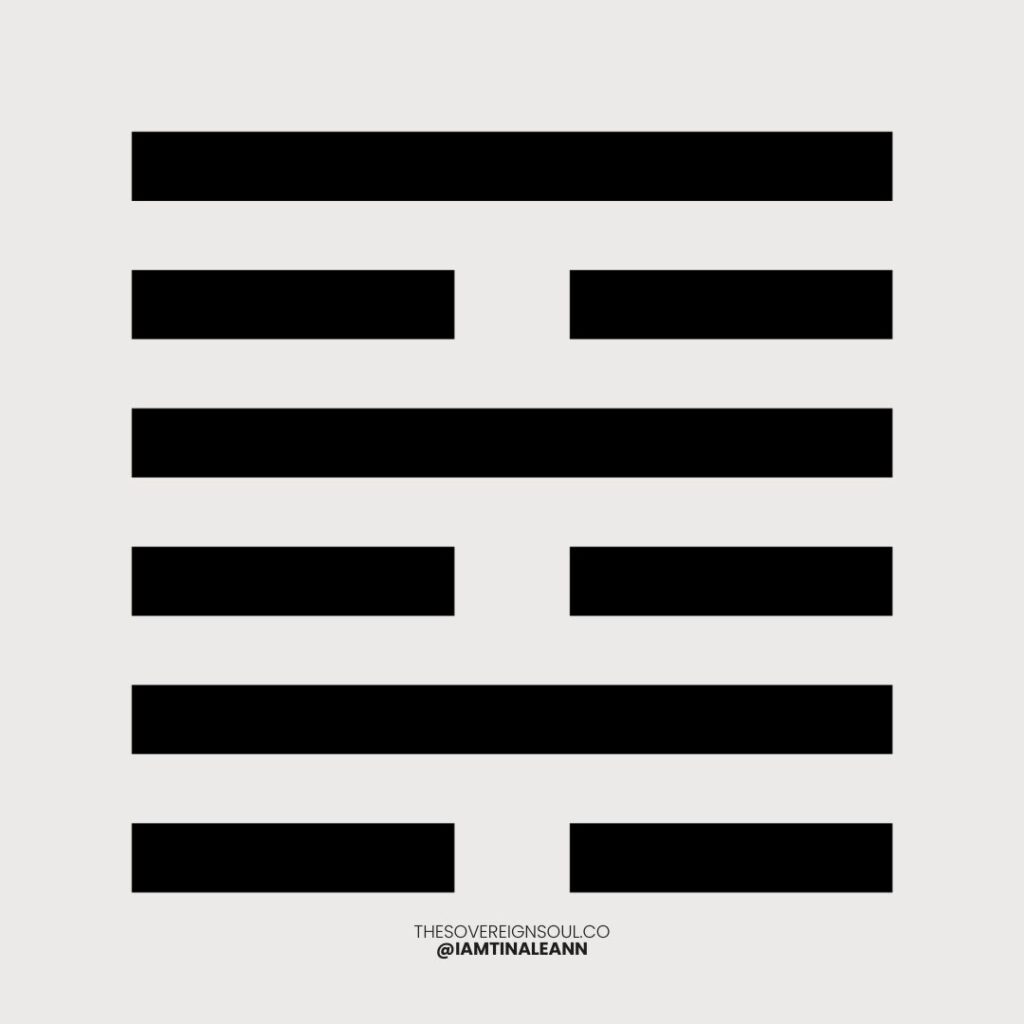Human Design Profile & What it Means
Your Human Design Profile is the third key—following your Type and Authority— in unlocking a fundamental aspect of your inner nature and how you interact with people and the world around you.
There are 64 Gates in the life chart that correspond to the 64 hexagrams in the I Ching. Each hexagram has six lines, thus six levels to each Gate’s structure. Lines 1, 2, and 3—the lower trigram—are intrapersonal energies around personal experiences. Lines 4, 5, and 6—the upper trigram—are transpersonal energies around relationship experiences.
A Profile consists of two numbers separated by a slash (e.g., 1/3)—the small numbers (Lines from the I Ching) next to the big numbers in your Sun sign, with the conscious first, followed by the unconscious.
Each Profile adds a layer of complexity to your Human Design, offering insights into your personal journey, interactions with others, and the overarching themes of your life. Understanding your Profile can help you navigate your path more effectively, embracing both your strengths and challenges.
12 Profiles
Right Angle – Personal Destiny
1/3 – Investigator/Martyr
Characterized by a deep need to explore and understand (1st Line) combined with a tendency to learn through personal experiences and sometimes trial and error (3rd Line).
1/4 – Investigator/Opportunist
Combines the foundational need for knowledge and investigation (1st Line) with the ability to make the most of opportunities through social interactions (4th Line).
2/4 – Hermit/Opportunist
Features the need for alone time and being in one’s own space (2nd Line) while also valuing connections and opportunities that come through others (4th Line).
2/5 – Hermit/Heretic
Blends the hermit’s nature of needing solitude (2nd Line) with a projection field that attracts others to project upon them what they think the 2/5 is capable of (5th Line).
3/5 – Martyr/Heretic
Merges the trial and error, experiential learning style of the 3rd Line with the capacity to project an aura of being a problem solver, often leading to high expectations from others (5th Line).
3/6 – Martyr/Role Model
Combines the experimental and learning from failure approach of the 3rd Line with the phased life process of the 6th Line, moving from trial and error to observer, and ultimately, to role model.
4/6 – Opportunist/Role Model
Mixes the opportunistic nature of the 4th Line, emphasizing connections and networks, with the life stages and wisdom-sharing aspect of the 6th Line.
Juxtaposition – Fixed Fate
4/1 – Opportunist/Investigator
The only profile with the lines in reverse order, focusing on the external world of opportunities and relationships (4th Line) backed by a need for a solid foundation and knowledge (1st Line).
Left Angle – Transpersonal Karma
5/1 – Heretic/Investigator
Features the 5th Line’s potential to be seen as a universal savior or problem solver, combined with the 1st Line’s need for a deep and solid foundation of knowledge.
5/2 – Heretic/Hermit
Combines the projection field and expectations of the 5th Line with the natural inclination of the 2nd Line to retreat and need for solitude.
6/2 – Role Model/Hermit
Merges the three-part life process of the 6th Line (trial, withdrawal, and emergence as a role model) with the natural talents and occasional need for solitude of the 2nd Line.
6/3 – Role Model/Martyr
Combines the life stages of the 6th Line with the experiential and sometimes chaotic learning process of the 3rd Line, leading to wisdom that can be shared as a role model.
“There is truly magic in the world and it is not something that I would have ever believed. The magic is in who we are, embedded into our own marvelous bodies like a rich vein of just waiting to be discovered. When we find this magic and tap into it’s power, it is as if we are sudddenly plugged into life at last. Finally, we can live our greatness, in peace, in grace, in power, by living our design.”
—Ra Uru Hu
Six Profile Lines
Line 1 – The Investigator
Key Characteristics of Line 1:
- Inquiry and Research: A strong drive to ask questions, investigate, and seek out information. Line 1 individuals are thorough in their search for knowledge and prefer to build upon a solid base of understanding.
- Foundation and Security: The need for a strong foundation is paramount for those with Line 1 influence. This foundation provides a sense of security and confidence from which they can operate.
- Self-sufficiency: There’s an element of self-reliance in Line 1, as these individuals often prefer to find answers on their own. They value the autonomy that comes from having a deep well of knowledge to draw upon.
- Detail-oriented: Attention to detail is a hallmark of the Investigator. They delve deep into subjects, often becoming experts in their fields or interests.
- Caution in New Endeavors: Because of their need for a solid foundation, Line 1 individuals can be cautious or hesitant when faced with new or unfamiliar situations. They prefer to thoroughly understand something before moving forward.
Line 1 in Relationships and Work:
- In relationships, Line 1 individuals seek depth and understanding. They value partners who are willing to explore the depths of their personalities and who can appreciate their need for a strong knowledge base.
- In the workplace, they excel in roles that require research, analysis, and expertise. They are the ones who provide a solid foundation upon which teams and projects can build.
Growth and Challenges:
- Growth: For Line 1 individuals, growth comes from learning to trust in their foundation and occasionally stepping into the unknown, even when they don’t have all the answers.
- Challenges: They may face challenges when their need for security prevents them from taking risks or when they get too caught up in the details, potentially missing the bigger picture.
Line 2 – The Hermit
Key Characteristics of Line 2:
- Natural Talent: Individuals with Line 2 in their profile often possess innate talents or gifts that seem to come naturally to them, without the need for formal training or instruction.
- Introversion and Need for Solitude: There’s a pronounced need for alone time, where the Hermit finds comfort and space to recharge and perhaps engage in their talents without the distractions of the external world.
- Recognition by Others: One of the unique aspects of Line 2 is that the talents and potential of these individuals are often recognized and called out by others. This external recognition can sometimes be the catalyst for the Hermit to fully embrace and develop their abilities.
- Reluctance to be Disturbed: People with a Line 2 influence might be reluctant to step out of their comfort zone or solitude unless there is a clear and appealing reason to do so. They often prefer to be left to their own devices.
Line 2 in Relationships and Work:
- In relationships, individuals with a Line 2 influence may require partners who understand and respect their need for alone time and personal space. They flourish in environments where their natural talents are appreciated and where they are not pressured to socialize or engage more than they feel comfortable.
- In the workplace, they are often seen as highly skilled or talented in areas that resonate with their innate abilities. They may not actively seek out leadership or highly social roles unless these positions align naturally with their interests and talents.
Growth and Challenges:
- Growth: For those with Line 2 in their profile, personal growth often involves recognizing and valuing their own talents as much as others do. Learning to balance their need for solitude with the benefits of social interaction and collaboration can also be a valuable growth area.
- Challenges: They may struggle with feelings of isolation or misunderstanding if they retreat too much or if others expect them to be constantly available. Additionally, there can be a challenge in stepping into their potential if they overly identify with the Hermit aspect and resist external calls to action.
Line 3 – The Martyr
Key Characteristics of Line 3:
- Trial and Error: Individuals with Line 3 prominently featured in their profile are inclined to learn by doing. They are experiential learners who often find themselves in situations where they can experiment and see firsthand what the outcomes will be.
- Adaptability: Due to their constant engagement with trial and error, these individuals develop a high level of adaptability. They are quick to adjust their strategies based on their experiences and are often resilient in the face of setbacks.
- Practicality: The Martyr line is grounded in the practical and the tangible. People with this line are oriented towards solutions that work in the real world, which often come from their direct experimentation and adjustments.
- Resilience and Persistence: The process of trial and error can lead to many perceived failures, but for Line 3 individuals, these are simply steps towards success. Their resilience allows them to keep pushing forward, learning from each experience.
Line 3 in Relationships and Work:
- In relationships, Line 3 individuals may go through a process of trial and error, learning what they want and need through direct experience. They value partners who are understanding of their need for growth and exploration and who can adapt alongside them.
- In the workplace, they excel in roles that allow for innovation, problem-solving, and the development of new methods or approaches. Their practical and experiential insights can be invaluable in refining processes and products.
Growth and Challenges:
- Growth: Growth for someone with a Line 3 influence involves embracing their unique path of discovery, learning to see each “failure” as a valuable lesson, and refining their approach to life and work based on their experiences.
- Challenges: The main challenge for Line 3 individuals is dealing with the frustration and discouragement that can come from repeated trials and errors. They may also face misunderstanding from others who do not appreciate the value of their experiential learning process.
Line 4 – The Opportunist
Key Characteristics of Line 4:
- Social Networking: Individuals with Line 4 prominently featured in their profile are adept at creating and nurturing social networks. They understand the importance of relationships and often have a natural talent for connecting with others in meaningful ways.
- Opportunity through Others: For Line 4 individuals, many of their opportunities in life—whether personal or professional—come through their connections. They are likely to find their next job, partner, or life-changing opportunity through someone they know.
- Loyalty and Friendship: Loyalty and strong personal bonds are important to those with a Line 4 influence. They value deep, lasting friendships and are often loyal and supportive friends themselves.
- Influence and Impact: Opportunists have the ability to influence and impact their social circle. Their opinions and ideas tend to spread through their networks, making them effective at initiating change or promoting causes within their communities.
Line 4 in Relationships and Work:
- In relationships, Line 4 individuals value stability and security. They seek partners who can be part of their social world and who understand the importance of friendship and community in their lives.
- In the workplace, they excel in roles that require strong interpersonal skills, such as sales, marketing, public relations, and management. Their ability to maintain relationships and leverage their network is a key strength.
Growth and Challenges:
- Growth: Growth for someone with a Line 4 influence involves learning to balance their social life with their personal needs for solitude and introspection. They may also benefit from discerning which relationships are truly reciprocal and supportive.
- Challenges: The main challenge for Line 4 individuals can be overly relying on their social network for validation or opportunities, which might lead to overlooking their own inner resources. Additionally, navigating the complexities of interpersonal relationships can sometimes be draining or distracting.
Line 5 – The Heretic
Key Characteristics of Line 5:
- Projection and Expectation: People with Line 5 in their profile frequently encounter projections from others. These projections can be both positive and negative, as people may see them as capable of solving problems or fulfilling needs that may not necessarily align with their true capabilities or desires.
- Universalization: Line 5 individuals have a knack for finding solutions or approaches that have a broad appeal. They can universalize concepts, making them accessible and applicable to a wide audience.
- Pragmatism and Practicality: Despite the often lofty expectations placed upon them, Line 5s are fundamentally pragmatic. They look for practical solutions to problems and can be very effective in crisis situations.
- Chameleon-like Ability: To navigate the projections and expectations, those with a Line 5 influence may develop a chameleon-like ability, adapting themselves to meet the varied demands or perceptions of others.
Line 5 in Relationships and Work:
- In relationships, the challenge for Line 5 individuals is navigating the gap between others’ projections and their authentic selves. They may find that partners or friends project an idealized image onto them, which can lead to misunderstandings or disappointments when the real person does not match the projection.
- In the workplace, Line 5s can be seen as charismatic leaders or go-to problem solvers. They often excel in roles that require quick thinking and the ability to address a wide range of issues. Their ability to communicate and universalize ideas makes them effective in roles that demand public speaking, teaching, or advocacy.
Growth and Challenges:
- Growth: For those with a Line 5 influence, personal growth involves learning to manage and clarify others’ projections. It’s crucial for them to establish clear boundaries and communicate their true capabilities and limits.
- Challenges: One of the main challenges is dealing with the weight of expectations and projections, which can sometimes lead to misunderstandings or feeling burdened by the perceived need to fulfill others’ needs or solve their problems.
Line 6 – The Role Model
Key Characteristics of Line 6:
- Three Phases of Life:
- The First Phase (0-approximately 30 years): Often involves trial and error, much like the Line 3 experience, where the individual learns through personal experiences, successes, and failures.
- The Second Phase (approximately 30 to around 50 years, up to the Chiron return): A period of withdrawal or stepping back. During this time, the individual takes on the role of the observer, reflecting on their experiences and gaining a broader perspective on life.
- The Third Phase (post-Chiron return, approximately 50 years and onwards): The individual steps into the role of the Role Model, embodying wisdom and often sharing insights gained from their life’s journey. They engage with the world from a place of wisdom and understanding, often inspiring others through their example.
Line 6 in Relationships and Work:
- In relationships, Line 6 individuals seek depth, honesty, and authenticity. Their experiences through the three phases of life give them a unique perspective on human dynamics, making them valued partners and friends who offer depth and wisdom.
- In the workplace, they excel in roles that allow them to mentor, guide, or influence others positively. Their broad perspective makes them effective in positions where they can contribute to the development and growth of individuals or organizations.
Growth and Challenges:
- Growth: Personal growth for someone with a Line 6 influence involves embracing their journey through its phases and recognizing the value of their experiences and wisdom. Engaging with life from a place of reflection and understanding can lead to fulfilling interactions and contributions.
- Challenges: The main challenge for Line 6 individuals can be the expectations placed upon them as role models. They may also struggle with the transition between life phases, particularly the shift from observer back to active participant in the third phase.






